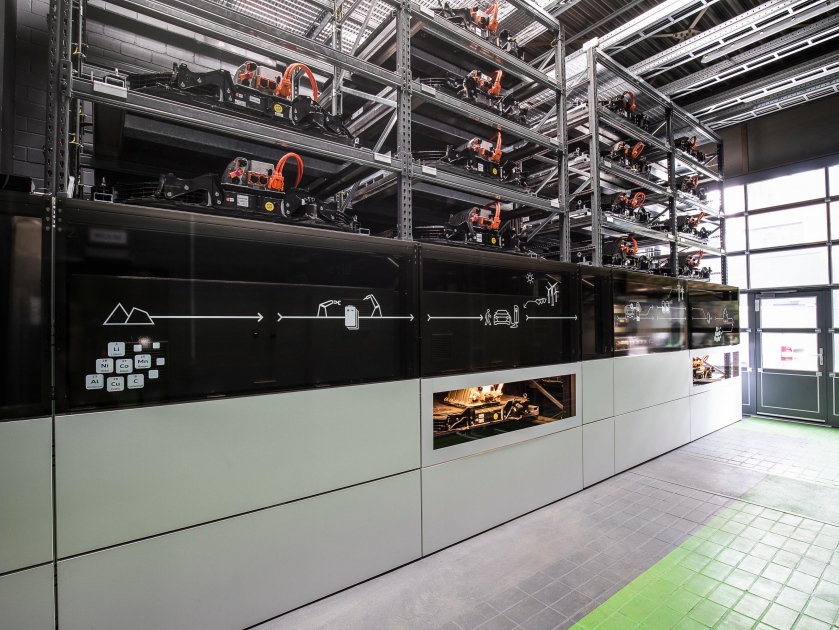
Audi Opens Battery Storage Unit on Berlin EUREF Campus
Audi is electrifying the capital: In the context of the Formula E
guest performance in Berlin, the brand with the four rings has opened up Germany’s
largest multi-use storage unit on the EUREF Campus, The storage unit has a capacity
of 1.9 MWh and uses used lithium-ion batteries from development vehicles to test
various interaction scenarios between electric cars and the power grid. The objective:
Intelligent networking to promote the energy transition.
Audi has committed to emissions-free mobility and set clear goals on the way to this vision:
One in three newly sold Audis is to be equipped with an electrified drive as early as 2025.
Audi will offer 30 electrified models by the middle of the next decade. As the number of
electric models rises, a huge mobile energy storage unit is growing with it. It carries a great
deal of potential, provided that intelligent use is made of the storage capacity. It is therefore
particularly important to integrate electric vehicles into the energy industry.
If one in ten passenger cars in Germany were electric, this would correspond to a flexible
energy storage unit with a capacity of almost 200 GWh. Connecting electric cars with
renewable energies in an intelligent way can have a positive effect on the energy transition.
This would allow charging with solar or wind power, depending on what is available. Further,
it would potentially allow flexible reactions to short-term power fluctuations in the grid. Audi is
cooperating with partners from the energy industry (e.g. The Mobility House) to turn this
vision into reality.
The storage unit on the EUREF Campus that is testing this concrete use case spans an area
of around 110 square meters and serves as a real-life laboratory for further applications. It is
connected to Berlin’s medium-voltage power grid with one megawatt of power, which
corresponds to the average charging requirement of around 200 electric cars. With its
capacity of 1.9 MWh, the storage unit could supply the entire 5.5 hectare office and science
campus with electricity independently for just under two hours.
Rapid-charging stations in the immediate vicinity, where electric cars can charge with up to
175 kW, are a further use case. To ensure that the high electricity requirement is covered in
the most cost-efficient way possible and the local power grid is not put under excessive
strain, the battery storage unit functions as a buffer here, too. Intelligent integration into the
power grid allows the energy reservoir to absorb excess electricity from wind power and
photovoltaic systems or the campus’s own combined heat and power plant. This
compensates for fluctuations in the grid, counteracts local peak demands, and helps prevent
blackouts by stabilizing the transmission network. Smoothing load peaks and compensating
for frequency fluctuations in this way reduces energy costs thanks to high levels of efficiency
and fast response times. In addition, the power supply is optimized in terms of its CO2
neutrality.
Due to the large portion of renewable energies with varying electricity generation in the
surrounding area, Berlin offers ideal conditions for the development of intelligent charging
control that may be expanded to include a growing number of electric cars as buffer storage
in the future. The project partners intend to conduct a model experiment with wind farms in
Brandenburg and Mecklenburg-West Pomerania to show how excess green electricity can
be buffered on the EUREF Campus in a targeted manner. Wind turbines would no longer
have to be taken off the grid in the event of temporary excess electricity production. It is a
small building block for a sustainable world of energy and an addition to the industrial storage
of large volumes of excess electricity that Audi has been practicing with its power-to-gas
plant in Werlte since 2013.
Aside from research on interfaces for intelligent integration into the power grid of the future,
the battery storage unit on the EUREF Campus provides further insights that will be
incorporated into future projects. Audi engineers are testing the use of stationary energy
storage units in the power grid, thereby creating a way to reuse used batteries from electric
cars—a sensible and resource-conserving application since batteries retain the majority of
their capacity after being used in cars. In addition, Audi is developing concepts for an
effective way to recycle batteries from used modules.


























